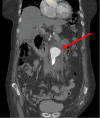Penetrating Aortic Ulceration With Pseudoaneurysm and Intramural Hematoma: Emergency Department Management and Point-of-Care Ultrasound Diagnosis
- PMID: 36060360
- PMCID: PMC9427664
- DOI: 10.7759/cureus.27536
Penetrating Aortic Ulceration With Pseudoaneurysm and Intramural Hematoma: Emergency Department Management and Point-of-Care Ultrasound Diagnosis
Abstract
Penetrating aortic ulcer (PAU) complicated by an intramural hematoma is a rare and potentially life-threatening emergency department (ED) presentation that is defined by progressive ulceration through the intima layer into the media layer of the aorta. Symptomatic PAUs can be clinically indistinguishable from other life-threatening pathologies such as aortic dissection, acute coronary syndrome (ACS), intrabdominal catastrophes as well as less lethal processes such as musculoskeletal back pain. Given the potential of PAUs to result in lethal aortic rupture and dissection, the emergency provider should maintain a high index of suspicion in patients with risk factors for aortic pathologies and utilize diagnostic modalities such as point-of-care ultrasound (POCUS) to expedite diagnosis.
Keywords: aortic dissection; aortic injury; aortic ulceration; emergency medicine; peripheral arterial disease.
Copyright © 2022, Huang et al.
Conflict of interest statement
The authors have declared that no competing interests exist.
Figures



Similar articles
-
Presentation, complications, and natural history of penetrating atherosclerotic ulcer disease.J Vasc Surg. 2012 Jan;55(1):10-5. doi: 10.1016/j.jvs.2011.08.005. Epub 2011 Nov 1. J Vasc Surg. 2012. PMID: 22047830
-
Radiologic Assessment of Acute Aortic Syndrome With Multiple Penetrating Atheromatous Ulcers: A Case Report.Cureus. 2025 Jan 18;17(1):e77633. doi: 10.7759/cureus.77633. eCollection 2025 Jan. Cureus. 2025. PMID: 39963641 Free PMC article.
-
Penetrating atherosclerotic ulcer.Curr Opin Cardiol. 2020 Nov;35(6):620-626. doi: 10.1097/HCO.0000000000000782. Curr Opin Cardiol. 2020. PMID: 32925190 Review.
-
A penetrating aortic ulcer rapidly evolving into aortic dissection in a patient presenting with respiratory tract infection to the emergency department: an acute aortic syndrome case report.Int J Emerg Med. 2024 Oct 2;17(1):132. doi: 10.1186/s12245-024-00724-z. Int J Emerg Med. 2024. PMID: 39358736 Free PMC article.
-
Intramural hematoma and penetrating ulcer in the descending aorta: differences and similarities.Ann Cardiothorac Surg. 2019 Jul;8(4):456-470. doi: 10.21037/acs.2019.07.05. Ann Cardiothorac Surg. 2019. PMID: 31463208 Free PMC article. Review.
References
-
- Penetrating atherosclerotic ulcerative disease of the aorta: do emergency physicians need to worry? Roldan CJ. J Emerg Med. 2012;43:196–203. - PubMed
-
- Intraabdominal infection: differences in presentation and outcome between younger patients and the elderly. Cooper GS, Shlaes DM, Salata RA. Clin Infect Dis. 1994;19:146–148. - PubMed
-
- Abdominal pain in geriatric emergency patients: variables associated with adverse outcomes. Marco CA, Schoenfeld CN, Keyl PM, Menkes ED, Doehring MC. Acad Emerg Med. 1998;5:1163–1168. - PubMed
Publication types
LinkOut - more resources
Full Text Sources
